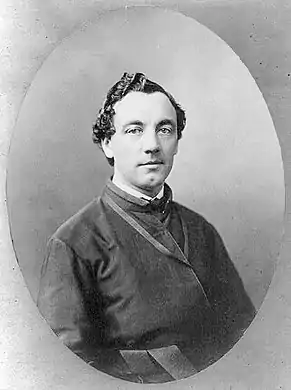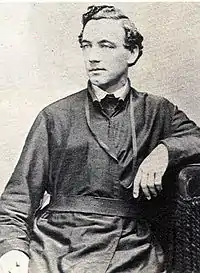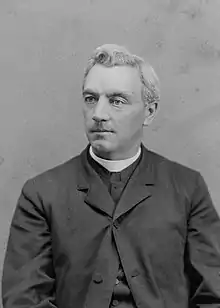Patrick Francis Healy
Patrick Francis Healy, S.J. (February 27, 1834 – January 10, 1910) was an American Catholic priest and Jesuit who became an important president of Georgetown University, resulting in his being known as its "second founder." The university's flagship building, Healy Hall, bears his name. Though readily passing for White, Healy would be posthumously recognized as the first Black American to earn a Ph.D., to become a Jesuit, and to become the president of a predominantly White university.
Patrick Francis Healy | |
|---|---|
 Healy in 1872 | |
| 29th President of Georgetown University | |
| In office 1874–1882 | |
| Preceded by | John Early |
| Succeeded by | James A. Doonan |
| Personal details | |
| Born | February 27, 1834 Macon, Georgia, United States |
| Died | January 10, 1910 (aged 75) Washington, D.C., U.S. |
| Resting place | Jesuit Community Cemetery |
| Relatives | Healy family |
| Alma mater | |
| Orders | |
| Ordination | September 3, 1864 |
Born in Georgia, Healy was legally a slave by birth, as his mother was one-eighth Black and his father was a White Irish immigrant, who, in the eyes of the law, owned his wife and children as slaves. Desiring to remove him from such conditions, Healy's father sent him north to be educated, first in New York and then at the College of the Holy Cross. Born into a family that produced many Catholic leaders, Healy decided to become a priest and entered the Society of Jesus. After his initial studies and teaching, he was sent to Europe to continue his higher education. In 1864, he received his doctorate in philosophy from the Catholic University of Louvain, and returned to Georgetown University to become the chair of philosophy.
Healy was promoted to prefect, and in 1874, was made the president of Georgetown University. While his fellow Jesuits were aware of his mixed race, he was widely regarded by the public as White. Healy's tenure would encompass a period of significant growth and reform of the university. Seeking to transform the institution into a modern university, Healy broadened the curriculum to more fully incorporate the sciences. He also raised the standards of the School of Medicine, and oversaw rapid growth of the Law School. Healy's most visible contribution to Georgetown was the construction of a grand, new building that would later become known as Healy Hall. While the building was largely completed by the end of his tenure, the project left the university in tremendous debt.
Experiencing declining health, Healy resigned the presidency in 1882, and went to live in Maine with his brother, James, the Bishop of Portland. The two traveled extensively throughout Europe. Afterwards, Healy returned to perform pastoral work in Rhode Island and New York City, before once again moving to Georgetown, where he died.
Early life
Patrick Francis Healy was born on February 27, 1834, in a log cabin in Macon, Georgia.[1][2] Patrick's father, Michael Morris Healy, had emigrated from Ireland to the United States, through Canada, in 1818.[3] On land that he won in the Georgia Land Lotteries, he established a cotton plantation on the banks of the Ocmulgee River[4] and owned 50 slaves at the time of his death.[5] One of those was Patrick's mother, Mary Eliza Smith,[lower-alpha 1] who Michael Healy purchased.[3] Eliza was one-eighth Black, known as an octoroon,[lower-alpha 2] making her children one-sixteenth Black.[8] One of her parents had fled Haiti for the United States in the 1790s, during the Haitian Revolution.[6]
As interracial marriage was prohibited by Georgia's anti-miscegenation law, Michael formed a common-law marriage with the 16-year-old Eliza in 1829.[3] While the Catholic Church did recognize interracial marriages, there were no priests in Macon County at that time to officiate.[8] Their marriage was unusual among interracial marriages in the South at the time in that neither had ever married anyone else, and after marriage, they lived with each other faithfully for the rest of their lives until both of their deaths in 1850.[6]
Patrick was the third of ten siblings, eight of whom would survive into adulthood.[6] His three sisters would go on to become nuns,[3] while two of his brothers would also become Catholic priests; one of them, James Augustine Healy, would become the Bishop of Portland,[8] and the first Black Catholic bishop in the United States.[4] Patrick and all of his siblings were born as slaves, as by the doctrine of partus sequitur ventrem, they inherited the legal status of their mother. Michael Healy was prevented by Georgia law from manumitting his wife or children, which was allowed only in exceptional circumstances, by an act of the Georgia General Assembly.[6]
Education

As slaves under the law, the Healy children were prohibited from attending school.[4] Wishing to remove his children from their conditions of slavery in Georgia,[6] Michael Healy sent all of his children to be educated in the North. At the time of his death in August 1850, he also intended to join them in the north.[9] Healy was at first unable to find a school in the north that would accept his children. However, he eventually found a Quaker school in Flushing, New York (now a neighborhood of Queens),[4] called the Flushing Quaker Academy,[10] that allowed the three oldest sons to enroll.[4]
Like three of his brothers,[4] Patrick Healy continued his education at the College of the Holy Cross in Massachusetts. He graduated in 1850, at the age of 16, and was awarded a Bachelor of Arts by Georgetown University, as Holy Cross had not yet been chartered and conferred degrees under Georgetown's charter.[7] After graduating, Healy entered the Society of Jesus on September 17, 1850, at the novitiate in Frederick, Maryland.[1] While he worried that his mixed race would present an obstacle to his entrance into the Jesuit order, this proved less of a concern than the fact because Healy's parents were never legally married in the eyes of the church, he was born out of wedlock. While under canon law, Healy required a dispensation to join the order, none was ever sought and he was admitted without issue.[11] With his admission to the Society of Jesus, he became the first Black American Jesuit.[12]
After two years of study, Healy professed his first vows, and was sent to teach at Saint Joseph's College in Philadelphia. The following year, he was transferred to Holy Cross.[13] While teaching there, he found that some students who knew his brothers learned of his racial background and made disparaging comments about him in secret.[11] In 1858, Healy went to Georgetown University, where he taught philosophy and theology.[13]
The Jesuit superiors at Georgetown were impressed by his skill in philosophy, and decided to send him to Europe, where he continued his study of philosophy and theology.[1] He first went to Rome, but during the winter, his health declined, and he was sent to Belgium to continue his studies at the Catholic University of Louvain.[13] While there, he was ordained a priest on September 3, 1864.[14] He also became fluent in Latin, French, Italian, and German.[15] On July 26, 1865, he received a Doctor of Philosophy in philosophy,[15] making him the first Black American ever to earn a Ph.D.[10]
Racial identity
Throughout his life, Healy's race was the subject of varying degrees of speculation. The Healy brothers considered themselves White, rather than Black.[16] Of them all, Patrick Healy most readily passed as White.[8] Indeed, his passport described his complexion as "light," suggesting he passed as a light-skinned White man, rather than a light-skinned Black man.[17] Though he himself identified as White, knowledge of his mixed race background would not be a secret while he served as president of Georgetown University.[8] His fellow Jesuits knew of his mixed race, but it is unlikely that this was widely known outside of Jesuit circles.[17]
Despite his appearance and self-identity, speculation as to his race remained with him. Orestes Brownson, who knew the Healy family personally, alluded to the Healy brothers who became priests as belonging to the category of "men with large admixture of negro blood, born of slave mothers," while decrying racism in the United States in an 1862 article.[8] Likewise, while in school, Patrick Healy faced rumors among classmates that his White but slightly dark complexion was due to the presence of some "Spanish blood."[17] Of the three priests, only one, Alexander Sherwood Healy, appeared as Black.[8]
Though Healy's racial background was not widely known during his lifetime, there was a resurgent interest in his history in the mid-20th century. In the 1960s and 1970s, Georgetown University began publicly identifying Healy as Black.[18]
Georgetown University
In 1866, Healy returned to Maryland, and was appointed the chair of philosophy at Georgetown University. After two years, he became the prefect of schools.[1] The following year, he professed his final vows.[13] On May 23, 1873, he also became the vice rector of the university.[19] As the president, John Early's, health began to fail, Healy increased assumed the duties of the presidency.[7] He initiated a reorganization of classes, established an alumni society,[1] and created three graduation medals: the Merrick Debating Medal, the Morris Historical Medal, and the Tower Scientific Medal. He also discontinued the monastic practice of have one student read aloud in the refectory during meals.[7] He also expressed his desire that a grand new building be constructed to connect Old North and the Maguire Building.[1]
As early as 1869, there was talk of naming Healy to succeeded Early's predecessor, Bernard A. Maguire. The provincial superior, Joseph Keller, had described Healy as the most qualified candidate, but the superiors in Rome, decided on Early due to Healy's race. When Early's health began to deteriorate, Keller proposed to the superiors in Rome that John Bapst succeed him, while Healy would replace Bapst as the president of Boston College, believing that his race would be less of an issue at the New England school. Rome rejected this arrangement, deciding that Bapst should remain in Boston.[20]
Presidency
.jpg.webp)
On May 23, 1873, Early died suddenly, and Keller made Healy the acting rector. The following day, the board of directors took the further step of electing him the acting president of Georgetown University. However, his appointment as rector by the Jesuit Superior General, which ordinarily was done around the same time as the selection of a new president, did not come until a year later. The delay was the result of concern in Rome over Healy's mixed race background.[20] On July 31, 1874, he was officially inaugurated as president and rector of the university. As such, he became the first Black president of a predominantly White university in the United States.[13] In a very unusual arrangement, he continued to hold the role of prefect until 1879, simultaneously with the office of president.[1]
In the year following his inauguration as president, Healy articulated his vision of transforming Georgetown into a true "university" to the Superior General, Peter Jan Beckx.[21] While Georgetown already fit the contemporary American definition of a university—a collection of degree-granting schools under one administration—Healy sought to remake Georgetown in the newly emerging notion of a university—an institution where a person could learn in any of a wide array of increasingly specialized academic fields.[22] In this way, he sought to make Georgetown into what the nation's bishops, gathered in 1866 at the Second Plenary Council of Baltimore, had envisioned: a great Catholic university in the United States that engaged in scholarship in every religious and secular subject.[23]
The demographics of the student body underwent change during Healy's tenure, with Northerners outnumbering Southerners for the first time. Meanwhile, the percentage of students who were Catholic increased to more than 80%, due in part to a growing Irish American middle class in the North that was able to send its sons to Georgetown.[24] Meanwhile, Healy created the first formal scholarship program that paid the tuition of one student from each of Washington's parishes.[25] He also reformed the university's approach to student discipline, bringing it ore closely in line with other contemporary American universities; rather than the university acting in loco parentis, it would treat students as being on the cusp of adulthood.[26]
Throughout his presidency, Healy experienced poor health, likely suffering from untreated epilepsy. In 1881, he went to live with his brother, James, in Maine to recover his health. Returning to Georgetown in February 1882, his condition quickly worsened and he resigned the presidency on February 16,[27] being succeeded by James A. Doonan.[28]
Curricular reform

Healy continued the reform of the curriculum he began as prefect by increasing the breadth of courses offered,[29] and, by 1879, allowing students to study the classical liberal arts curriculum or a new "commercial and scientific" one.[29] Graduates of this new scientific curriculum received a Bachelor of Science degree.[30] Healy recruited new Jesuit faculty with higher academic credentials to support this curricular improvement.[31] Despite the new emphasis on science, Healy revitalized the university's commitment to rhetoric. In 1875, he established the Merrick Debate, hosted by the Philodemic Society, following a donation by alumnus Richard T. Merrick. He also gave the Society a privileged place among student groups by setting aside its own room in Healy Hall.[32]
In addition to reforming undergraduate science education, Healy sought to bring the School of Medicine up to rigorous, modern medical standards.[33] While the school had previously operated almost entirely autonomously of the rest of the university, Healy dissolved its governing board, bringing the school under his direct control, and replaced the entire faculty (with only the founding faculty remaining as professors emeriti).[34] The length of the curriculum was lengthened from two to three years, which now included clinic education. An entrance exam was given for the first time to applicants.[35]
During Healy's presidency, the Law School saw significant growth, driven in large part by the District of Columbia Bar's decision to require new applicants to the bar to have completed three years of formal legal education.[36] In the early 1880s, the school relocated twice within Downtown Washington, but was financially unable to move to the university's Georgetown campus as it desired.[37]
Constructing Healy Hall
Healy determined that Georgetown's most pressing need was to expand its physical facilities. He and Keller entertained the possibility of relocating to a new, nearby campus north of New Cut Road (today known as Reservoir Road), or moving the university out of Washington entirely. However, the cost of both of these proposals was prohibitive, and they decided instead to improve the existing campus. Replacing plans for the construction of several smaller buildings, Healy undertook to construct the grand building that he envisioned as prefect in an embellished architectural style that contrasted with the city's simple Federal architecture.[29]

In 1874, Healy commissioned architects John L. Smithmeyer and Paul J. Pelz to design what would later become known as Healy Hall,[29] Georgetown's flagship building.[38] The building would rise five stories, topped by a 200-foot (61 m) clock tower, and incorporate elements from a variety of architectural styles into a primarily Romanesque facade, evoking the ancient universities of Europe. It would house classrooms, offices, an auditorium (later known as Gaston Hall), laboratories, a library, and students dormitories. Groundbreaking occurred in 1877, after obtaining the reluctant approval of the provincial superior, who was wary of the cost of constructing one large, ornate building and authorized $100,000 to be spent,[39] equivalent to $2.4 million in 2019.[40] By far the largest project Georgetown had ever undertaken, construction of the building required the university, which was already suffering from the Panic of 1873, to finance the entire project on debt.[39]
In order to sustain the project, in 1880, Healy re-established Georgetown's alumni association, which had gone defunct four years earlier. He also solicited William Wilson Corcoran, the university's oldest living alumnus, to become president of the association and to raise funds. Despite the creation of the alumni association and a donation by Corcoran, after several years, only a small fraction of the $100,000 was raised. Therefore, from 1878 to 1880, Healy left the university to travel the country to raise funds. In 1878, he sailed to San Francisco, California by way of the Isthmus of Panama, with the president of the College of the Holy Cross, Joseph B. O'Hagan. Though also to engage in fundraising, this voyage was primarily intended to improve Healy's declining health.[41] The following year, he returned by land, crossing the Midwest to New York City and down the East Coast. Despite his extensive efforts, Healy was only able to raise $60,000.[42]
Meanwhile, as construction on the building progressed, so did costs. In November 1879, the building's exterior was complete, at a cost of more than $150,000.[43] After a halt in construction, work began on the interior in 1880, requiring additional, large loans to be taken out. The building was put to regular use in 1881, and by the following year, almost $440,000 had been expended on the project, equivalent to $11.7 million in 2019.[40] Facing a dire financial situation, the university laid off staff, including all its lay faculty,[44] and began leasing and selling properties it owned in Washington, Virginia, and Pennsylvania.[45]
Later years
After leaving Georgetown, Healy returned to Portland, Maine, to live with his brother.[28] With James, he traveled extensively throughout Europe, visiting major Catholic institutions in France, Spain, Italy, and Belgium.[46] Despite his travels, for the remainder of his life, his health would never recover. After some time, he went to Providence, Rhode Island, where he performed limited pastoral work.[27] He returned to New York City, where he was assigned to the Church of St. Ignatius Loyola. Several years later, he moved back to Georgetown University to live out his final years.[28]
Healy died at Georgetown on January 10, 1910.[7] His funeral was held in Dahlgren Chapel, and his body was interred in the Jesuit Community Cemetery on the university's campus.[28] By the time of his death, Healy was frequently referred to as the "second founder" of Georgetown, for presiding over a period of unprecedented growth in the university's history.[27]
In 1969, the Georgetown University Alumni Association created the Patrick Healy Award, which is presented annually to an individual who is not an alumnus of the university but has contributed to it and upheld its ideals and traditions.[47]
See also
Notes
References
Citations
- Obituary: Father Patrick F. Healy 1910, p. 387
- Picott 1978, p. 803
- Sullivan 2002, p. 5
- Ferraro, William M. "Patrick Healy Builds a University". Georgetown University Library. Archived from the original on December 15, 2013. Retrieved July 28, 2020.
- O'Toole 1996, p. 13
- O'Toole 1996, p. 10
- O'Connor 1955, p. 176
- O'Connor 1955, p. 175
- O'Toole 1996, p. 11
- Cooke, Janet (March 13, 1980). "G.U. Honors Memory Of Patrick Healy, Pioneer in Education". The Washington Post. Archived from the original on July 28, 2020. Retrieved July 28, 2020.
- O'Toole 1996, p. 17
- "Patrick Francis Healy". National Park Service. September 14, 2017. Archived from the original on July 31, 2020. Retrieved July 31, 2020.
- "Today in History - July 31". Library of Congress. Archived from the original on June 28, 2020. Retrieved June 29, 2020.
- Sharps 1994, p. 123
- "Passing Grade: Patrick Francis Healy's Academic Achievements". Arthur Ashe Learning Center. July 26, 2016. Archived from the original on July 28, 2020. Retrieved July 28, 2020.
- O'Toole 1996, p. 12
- O'Toole 1996, p. 16
- Redden, Molly (April 14, 2010). "On the Record: Georgetown and the racial identity of President Patrick Healy". The Georgetown Voice. Archived from the original on May 17, 2017. Retrieved August 2, 2020.
- Sharps 1994, p. 174
- Curran 1993, p. 280
- Curran 1993, p. 281
- Curran 1993, p. 282
- Curran 1993, p. 283
- Curran 1993, p. 292
- Curran 1993, p. 293
- Curran 1993, p. 303
- Curran 1993, p. 319
- Obituary: Father Patrick F. Healy 1910, p. 389
- Curran 1993, p. 284
- Curran 1993, p. 295
- Curran 1993, p. 291
- Curran 1993, p. 301
- Curran 1993, p. 308
- Curran 1993, p. 309
- Curran 1993, p. 311
- Curran 1993, p. 316
- Curran 1993, p. 317
- Highsmith, Carol M. "Georgetown University's flagship building, Healy Hall, Washington, D.C." Library of Congress. LCCN 2011635431. Archived from the original on September 13, 2020. Retrieved September 13, 2020.
- Curran 1993, p. 285
- Federal Reserve Bank of Minneapolis. "Consumer Price Index (estimate) 1800–". Retrieved January 1, 2020.
- Curran 1993, p. 286
- Curran 1993, p. 287
- Curran 1993, p. 288
- Curran 1993, p. 289
- Curran 1993, p. 290
- Foley 1954, pp. 83–84
- "Patrick Healy Award Recipients". Georgetown University Alumni Association. Archived from the original on February 22, 2018. Retrieved August 2, 2020.
Sources
- Curran, Robert Emmett (1993). The Bicentennial History of Georgetown University: From Academy to University, 1789–1889. 1. Washington, D.C.: Georgetown University Press. ISBN 978-0-87840-485-8. Archived from the original on July 29, 2020. Retrieved July 29, 2020 – via Google Books.
- Foley, Albert S. (1954). Bishop Healy: Beloved Outcaste, The Story of a Great Priest Whose Life has Become a Legend. New York: Farrar, Straus and Young. OCLC 1120390826. Retrieved August 2, 2020 – via HathiTrust Digital Library.
- "Obituary: Father Patrick F. Healy" (PDF). Woodstock Letters. 39 (3): 387–389. October 1910. Archived (PDF) from the original on July 28, 2020. Retrieved July 28, 2020 – via Jesuit Archives.
- O'Connor, John J. (May 1955). "A Negro President at Georgetown University Some Eighty Years Ago". Negro History Bulletin. 18 (8): 175–176. JSTOR 44176904.
- O'Toole, James M. (1996). "Passing: Race, Religion, and the Healy Family, 1820–1920". Proceedings of the Massachusetts Historical Society. Third series. 108: 1–34. JSTOR 25081113.
- Picott, J. Rupert (March–April 1978). "Editorial Comment". Negro History Bulletin. 41 (2): 803. JSTOR 44213825.
- Sharps, Ronald L. (Winter 1994). "Black Catholics in the United States: A Historical Chronology". U.S. Catholic Historian. 12 (1): 119–141. JSTOR 25154014.
- Sullivan, Eileen A. (Fall 2002). "Review: Look Away Dixie Land". Irish Literary Supplement. 21 (2): 5. Archived from the original on July 28, 2020. Retrieved July 28, 2020 – via Boston College Libraries.
Further reading
- Foley, Albert S. (1955). God's Men of Color: The Colored Catholic Priests of the United States, 1854–1954. New York: Farrar, Straus. OCLC 974657306. Retrieved August 2, 2020 – via Google Books.
- Newman, Richard (1999). "Healy, Patrick Francis". American National Biography (online ed.). New York: Oxford University Press. doi:10.1093/anb/9780198606697.article.0800655. (subscription required)
- O'Toole, James M. (2003). Passing for White: Race, Religion, and the Healy Family, 1820–1920. Amherst, Massachusetts: University of Massachusetts Press. ISBN 1-55849-417-0 – via Google Books.
| Academic offices | ||
|---|---|---|
| Preceded by John Early |
29th President of Georgetown University 1874—1882 |
Succeeded by James A. Doonan |
